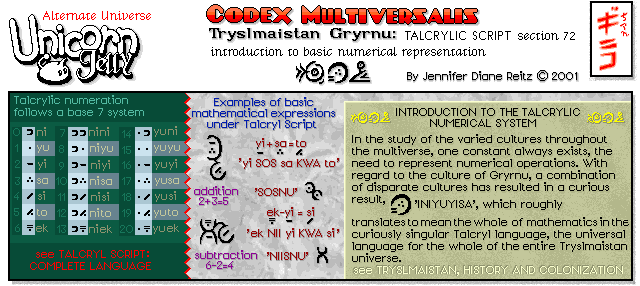
Note that this is not just your run-of-the-mill base 7 number system. If it were, you could just convert your number into base 7, change symbols and be done with it. But it doesn't quite work that way. Look at the symbol for the number 7. It's

 "nini", which means "zero-zero". That's very
surprising! (If it were plain vanilla base 7, you'd expect
"nini", which means "zero-zero". That's very
surprising! (If it were plain vanilla base 7, you'd expect 
 "yuni", which means "one-zero"... much as
"one-zero" means "ten" in base ten.) You can't
just stick a zero in front of a Talcryl number and expect it not to
change. A leading zero changes the value of the number, which means
that you can actually get more numbers out of fewer digits.
"yuni", which means "one-zero"... much as
"one-zero" means "ten" in base ten.) You can't
just stick a zero in front of a Talcryl number and expect it not to
change. A leading zero changes the value of the number, which means
that you can actually get more numbers out of fewer digits.The two-digit numbers go all the way up to

 "ekek", which corresponds to fifty-five. (In normal base
seven, you can only go up to forty-eight with two digits.) Three-digit
numbers start with fifty-six, which is
"ekek", which corresponds to fifty-five. (In normal base
seven, you can only go up to forty-eight with two digits.) Three-digit
numbers start with fifty-six, which is 

 "ninini", and go all the way up to
"ninini", and go all the way up to 

 "ekekek", which corresponds to three hundred ninety-eight,
and so on and so forth.
"ekekek", which corresponds to three hundred ninety-eight,
and so on and so forth.Converting between decimal and Talcryl is therefore a little bit more involved. Read on if you care, or just use the automatic converter.
To get the value of a Talcryl number, first convert the digits to standard Arabic numerals (mostly for ease of explanation.) Then, add one to each digit except the last one. Now multiply each digit by the appropriate power of seven, (as if it were a standard base seven number.) Example:
Talcryl:


 "niekyi"
"niekyi"Convert to Arabic: 0 6 2
Add one to all digits except the last one: 1 7 2
Pretend this is base seven: 172 + 771 + 270 = 49 + 49 + 2 = 100 "one hundred".
Writing a number in Talcrylic is basically the reverse process, but is trickier since it involves some "borrowing" like in longhand subtraction. Write the number in standard base seven. Now subtract one from each digit except the last one. You may have some minus-ones now. If so, "borrow" one from the previous digit and add seven to the negative digit. If the first digit is minus-one, simply remove it. Keep borrowing and removing until you've eliminated all the negatives. Now convert to Talcrylic glyphs and you're done. Example:
Decimal: 365 "three hundred sixty-five".
Convert to base seven: 1 0 3 1... (173 + 072 + 371 + 170 = 343 + 0 + 21 + 1 = 365)
Subtract one from all digits except the last one: 0 -1 2 1
Borrow to eliminate the negative: 0-1 -1+7 2 1... becomes -1 6 2 1.
Now the first digit is minus-one, so remove it: 6 2 1
Replace with Talcrylic glyphs:


 "ekyiyu".
"ekyiyu".Well, there you have it. Hopefully it made some sense. I haven't really thought about how you'd do longhand arithmetic, or how you would represent fractional numbers with symbols to the right of a "Talcrylic Point". And yes, I think this stuff is fun. Really. Stop laughing at me.






 Back to converter
Back to converter 





